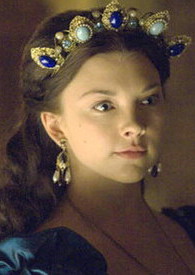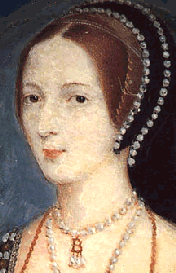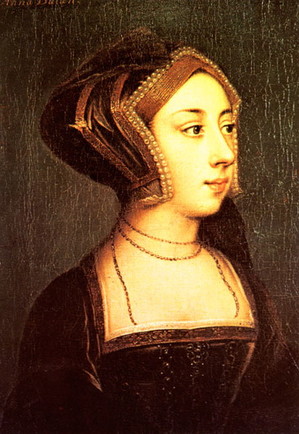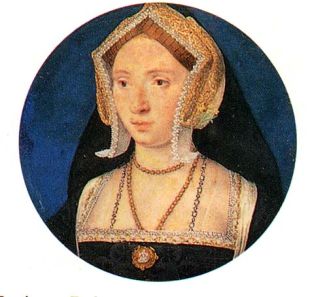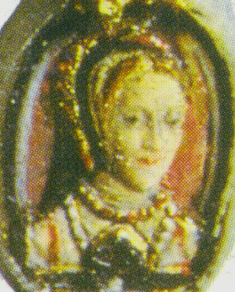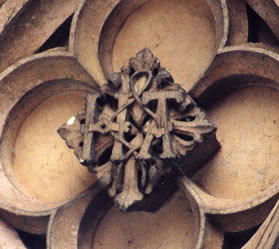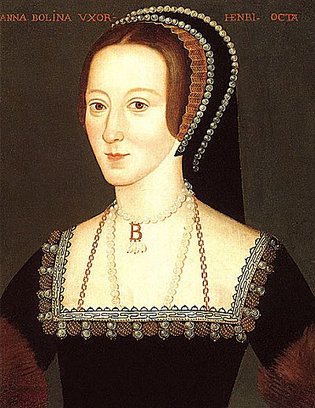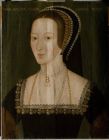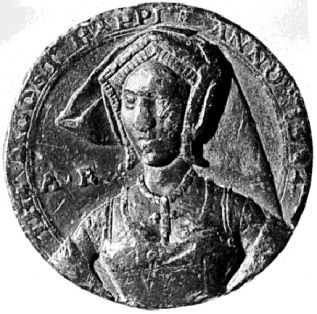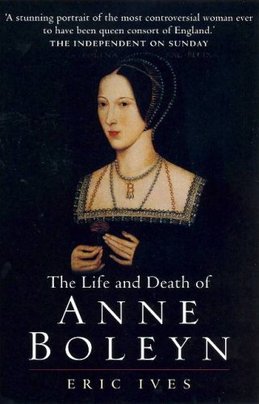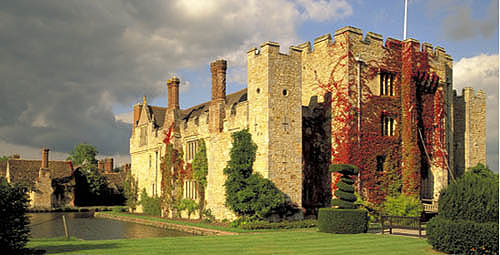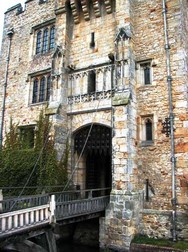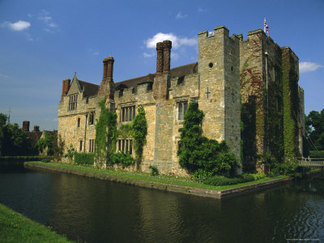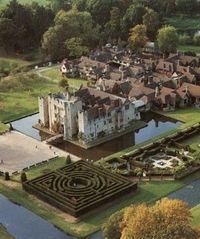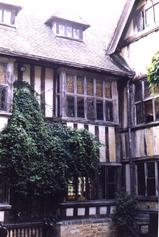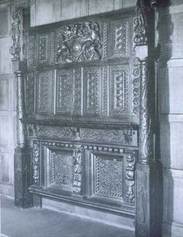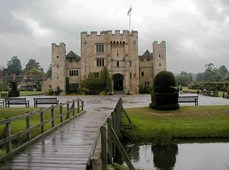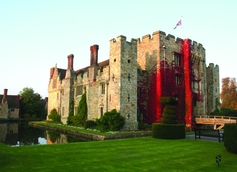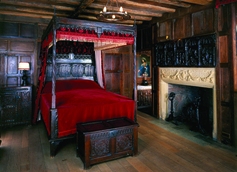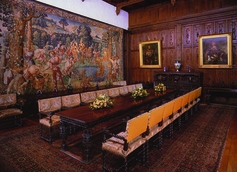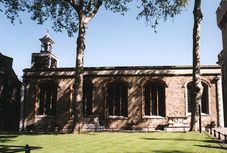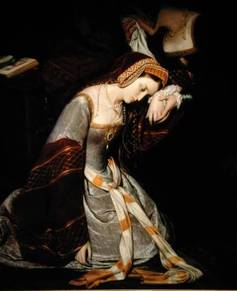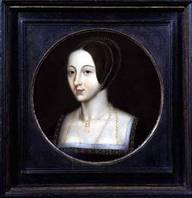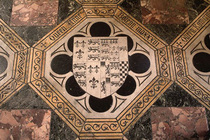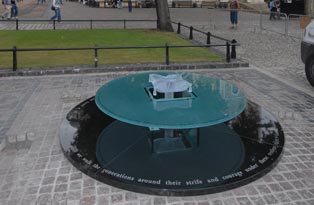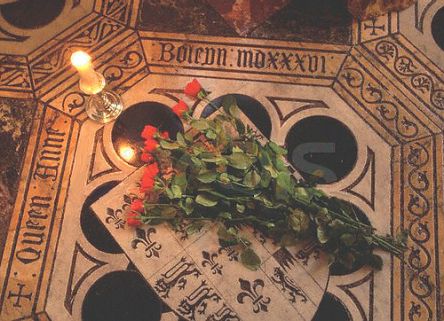Anne Boleyn - Historical Profile
Queen Consort May 28th, 1533 - May 19th, 1536
| INTERESTING FACTS : - As a young girl, Anne made a great impression at the French court , even Francis I admired her and wrote: At the same, time "no breath of scandal attached itself to her at the time." [Weir] - I find her so bright and pleasant for her young age that I am more beholden to you for sending her to me than you are to me. —Archduchess Margaret of Austria, who trained Anne as a maid of honour in her household wrote to her father. - Apart from Katherine of Aragon, Anne was the only one of Henry's subsequent wives to have a coronation. Hers was exceptionally elaborate, and partially designed by Holbein.  - She is the only consort, before or since, to have been crowned with the St Edward crown, which is reserved for the actual monarch.The original crown was lost when Oliver Cromwell melted it down during the English Civil War Today's crown (shown right) was refashioned in the 17th century but we still have the description and picture of the crown which Anne is though to have worn at her coronation: 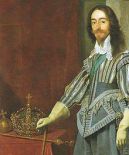 'The state crown of Henry VII had five fleurs-de-lis, five crosses and two arches topped by a gold orb and cross. The five fleurs-de-lis each had the enameled image of a saint on the central upright petal (the front fleur-de-lis had an image of the Virgin and Child, while two of the other fleurs-de-lis had images of St George and the dragon) as well as precious stones on the two curved side petals, while the five crosses and the arches were ornamented only with precious stones.' 'The state crown of Henry VII had five fleurs-de-lis, five crosses and two arches topped by a gold orb and cross. The five fleurs-de-lis each had the enameled image of a saint on the central upright petal (the front fleur-de-lis had an image of the Virgin and Child, while two of the other fleurs-de-lis had images of St George and the dragon) as well as precious stones on the two curved side petals, while the five crosses and the arches were ornamented only with precious stones.' This crown was recorded in the portrait of Charles I - the last English monarch to have worn it. [Source Sarah Morris - author of[Le Temps Viendra: A Novel of Anne Boleyn]] - Anne supported and defended the censored writing of religious reformers, but retained elements of traditional Catholicism (transubstantiation) in her private worship. Her primary concern was purging the Church of abuses (selling of indulgences) and superstitions (worship of relics). - Pope Clement VII paid spies to steal Henry VIII's love letters to his fiancée, Anne Boleyn, to prove that they were lovers. However, no evidence could be uncovered and even Clement VII had to grudgingly admit that all impartial evidence from England suggested that Anne Boleyn was strong-willed, but morally upright. *See: <a class="external" href="http://www.youtube.com/watch?v=pq_qK_FXnhQ" rel="nofollow" target="_blank" title="David Starkey discusses Henry's love letters to Anne">David Starkey discusses Henry's love letters to Anne</a> - Henry VIII wrote at least seventeen (undated) love letters - in French and English - to Anne Boleyn, in his own hand, quite remarkable as he normally employed an amanuensis. None of her reciprocal letters survive. The letters, since at least the late 17th C., have been in the Vatican. *See: King Henry VIII in his own wordsfor full transcripts of the letters - She convinced Henry that The Bible should be translated into the vernacular and be available to the common people and not only clerical intermediaries; she owned a highly controversial French Bible. - She gave more money to the poor in three years than Katherine of Aragon did during her entire reign of more than 20 years. She even sewed clothing with her own hands to distribute to the poor & personally tended to the ill on her travels. When Cromwell wanted Church revenues poured into the King's depleted coffers, she preferred the money be distributed to the poor and educational resources. In the summer of 1535 when she and Henry went on their summer progress of the west country, she spent more time than her husband inquiring as to the state of the religious houses, offering aid, etc. - She had a droll sense of humour and when there were protests to Henry choosing her as queen, for a short time, she changed her motto to the Latin equivalent of "Grumble all you like. This is how it's going to be" (Ainsi sera, groigne qui groigne) and this was emblazoned on all her blue & purple livery. A few weeks later, it was removed. - George Wyatt (grandson of Thomas Wyatt) wrote: "There was found, indeed, upon the side of her nail upon one of her fingers, some little show of a nail, which yet was so small, by the report of those that have seen her, as the workmaster seemed to leave it an occasion of greater grace to her hand, which, with the tip of one of her other fingers, might be and was usually by her hidden without any least blemish to it." He also commented on "certain small moles, incident to the clearest complexions." Upon exhumation in 1876, no abnormalities of her hands were detected. No contemporary mentions any deformities; Nicholas Sander, enemy of Elizabeth I, was the first to describe her as having six fingers and a disfiguring "wen" on her neck. - No heretics were burned during her tenure as queen, and in fact, she saved the life of one Nicholas Bourbon. [* See notes below] -Anne is probably the only person to have ever said "no" to the King's advances, which made her a challenge when he first encountered her. [* See discussion threads below] - When Anne was created the first Marchioness of Pembroke in 1532, she became the first female English commoner ennobled in her own right, without inheritance or marriage, and at the time became the most prestigious non-royal woman in the land. - Anne was the wealthiest of all Henry's wives, including Katherine of Aragon and Henry lost a lot of money to her playing cards. - Anne played an enormous role in England's international position, by solidifying the French alliance. She established an excellent rapport with the French Ambassador, de la Pommeraye, who was captivated by her. - Anne was almost certainly the only wife of Henry VIII with a particular interest in architecture, which she shared with her husband. Building plans for Whitehall Palace were sent to Henry and Anne for approval and interestingly Henry allowed her a significant say in decorations. Unfortunately for Anne, she never lived to see the building work completed. - She became the victim of a public hate campaign, mobilised by Katherine of Aragon's supporters, and in 1531, a crowd of 8,000 women marched through the streets of London in an attempt to lynch her. However, at the time of her execution, public sympathy lay with her and not Henry VIII. - Within 11 days of her arrest, Anne's whole household of 250 were disbanded, before the trial verdict and within 3 weeks Jane Seymour was installed as queen and many returned to serve the new queen. However, the Queen's Mistress of the Wardrobe, Lady Margaret Lee, went into retirement rather than serve Jane. - When Henry Norris refused to give evidence against Anne Boleyn, he said that he: "would rather die a thousand deaths than accuse the Queen of that which I believe her, in my conscience, innocent." - The French swordsman was paid 23 pounds to reduce her suffering to a minimum and he took her head in one try. His name was Jean Rombaud & he was so skilled he once beheaded two felons with one stroke. Executions were routinely botched and often took several strikes to sever the head. Anne was worried about this, having witnessed it, and it was Henry's last act of "kindness". This portrait is at Hever Castle; it is an early 19th Century oil painting based on Holbein's drawing of an unknown lady on the right Miniature by Lucas Horenbout / Horenbolte.c. 1526 Unknown sitter: badge is a pelican, not a falcon; Anne Boleyn did not adopt the falcon until queen. Eric Ives believes the miniature to be one of Henry VIII's nieces - Margaret Douglas or Frances Brandon. However, Sir Roy Strong, eminent art historian (expertise in the portraits of Elizabeth I) and former curator of both the National Portrait Gallery & the Victoria & Albert Museum, once suggested that this miniature is a likeness of Anne Boleyn, and it bears a certain resemblance to the Holbein drawing on the top right. For this reason, the portrait is included here. Note: Sir Roy Strong's attribution has been dismissed, as the most recent research indicates the image is not of Anne Boleyn due to a misinterpretation of the badge and that she was not yet sufficiently significant to warrant a portrait by the artist, whose subjects (at this time) were limited to royalty. This portrait has also been said to be either Jane Seymour or Anne's sister Mary Boleyn
"H" and "A" for Henry and Anne under Anne Boleyn's gateway in Hampton Court Palace 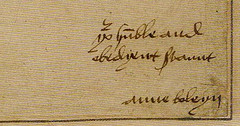 from a letter Anne Boleyn wrote to Cardinal Wolsey before she was queen |
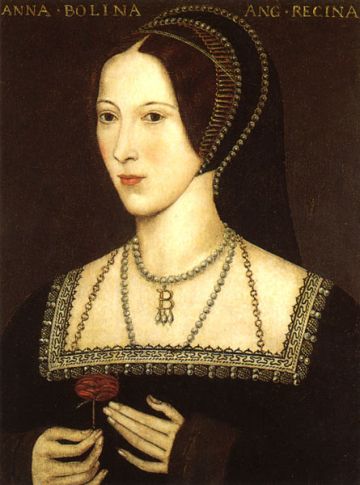 by Unknown artist at Hever Castle (Cover picture of Eric Ives Biography of Anne) No contemporary portrait of Anne Boleyn survives: the drawing below was identified as her during the 18th century; however, many Holbein drawings at Windsor were incorrectly labeled. See also : <a class="external" href="http://web.archive.org/web/20080410124212/http://www.geocities.com/rolandhui_2000/ab_portraiture.htm" rel="nofollow" target="_blank" title="A Reassessment of Queen Anne Boleyn’s Portraiture by Roland Hui">A Reassessment of Queen Anne Boleyn’s Portraiture by Roland Hui</a> 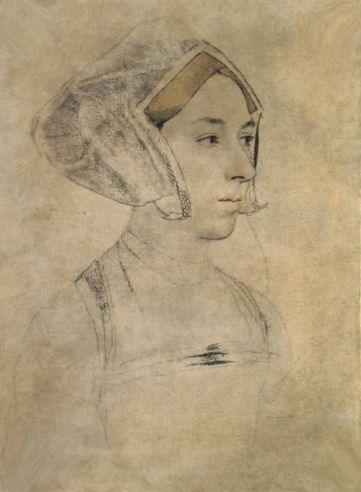 Unknown lady, inscribed "Anne Bullen decollata fuit Londini 19 May 1536" The association of this drawing with Anne Boleyn goes back to Wenceslas Hollar's etching after it in 1649. It is not known whether the inscription on the etching was taken from the drawing or vice versa. The inscription on the drawing (left of neck) dates from the 17th century. The identification may have been based on a superficial similarity with some of the late-Elizabethan hack images of Anne. Anne's biographer Eric Ives believes that neither this nor the portrait below inscribed "Anna Bollein Queen" are of Anne. The drawing below is disputed and may have been a member of the Wyatt family, perhaps Thomas Wyatt's estranged wife, Elizabeth Brooke.Dr. David Starkey insists the drawing is of a pregnant Anne Boleyn, arguing that such 'undress' on the part of this ‘royal’ sitter was a novelty of sorts to relax the dictates of court etiquette. However, other opinions are that it is unlikely that Anne, with her much commented upon sense of style, would have permitted herself to be depicted as such. The attribution is by Sir John Cheke, Edward VI's tutor, who may have seen her, but many of his attributions have been proven incorrect. 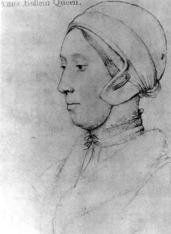 Unknown lady, inscribed "Anna Bollein Queen" The only surviving contemporary likeness of Anne from her lifetime is this coin medal above from 1534 commemorating her second pregnancy, inscribed with her motto: "The Moost Happi"; severely damaged about the nose and left half of her face. 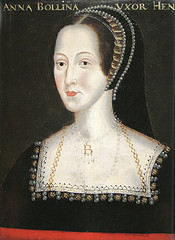 According to Tudor Historian Eric Ives : “This painting is an example of the standard likeness of Anne and probably belonged to one of the sets of royal portraits that English gentry liked to display in order to demonstrate loyalty. The likeness corresponds to the only contemporary likeness of Anne, [the above] portrait medal in the British Museum, London, and is confirmed by comparison with a tiny enamel of her [at left], owned by Elizabeth I, and now at Chequers. Thus this portrait must ultimately derive from a lost portrait originally taken from life. Other examples of the standard likeness give Anne a more sallow complexion, something noted by her contemporaries, so indicating that this portrait has been somewhat ‘glamorized’, a process that is taken further in subsequent copies. Anne’s allure came from her personality, education and style, not from her good looks.” The portrait is currently (2009) on display at the “Henry VIII: Man and Monarch” exhibit at the British Library. 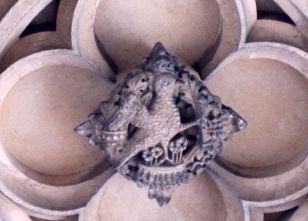 Falcon, Anne's Badge at Hampton Court - Victorian replicas
|
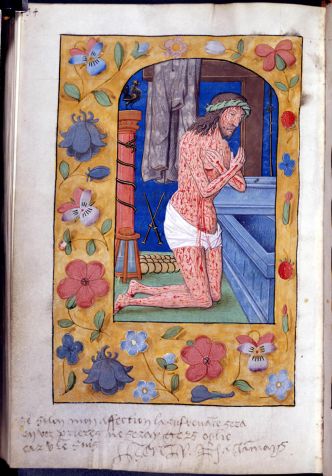 <a class="external" href="http://www.bl.uk/onlinegallery/onlineex/henryviii/greatmatter/annebol/index.html" rel="nofollow" target="_blank" title="[Source: British Library online]">[Source: British Library online]</a> "Henry and the court regularly attended Mass in the royal chapel, sometimes more than once a day.The King often used the time before the consecration to transact business but this manuscript shows him using a book of prayers to send a flirtatious message to Anne Boleyn instead. He wrote in French: ‘If you remember my love in your prayers as strongly as I adore you, I shall hardly be forgotten, for I am yours. Henry R. forever.’ Presenting himself as lovesick, he wrote his note on a page depicting the man of sorrows. Anne replied with a couplet in English: 'By daily proof you shall me find To be to you both loving and kind.' And, with deliberate enticement, she chose to write her message below a miniature of the Annunciation, the angel telling the Virgin Mary that she would have a son." |
| LITERATURE Non-Fiction:
| Primary Sources:
Fiction:
|
The Boleyn family home - Hever Castle in Kent
| <embed align="left" height="266" src="http://wikifoundrytools.com/wiki/thetudorswiki/page/Anne+Boleyn+-+Historical+Profile/widget/youtubevideo/829001408" type="application/x-shockwave-flash" width="326" wmode="transparent"/> Video exploring the authorship of "Oh death rock me asleep" by TheBullen1 aka Owen (YouTube) "Martin Pope discovers whether Anne did write the attributed poem/ song 'O Death Rock Me Asleep' which history would have us believe that Anne wrote on her last night in the Tower of London, prior to her Execution on 19th May 1536. The video includes a very short clip of one of my heroes -- Dr Eric Ives, whose book 'The Life and Death of Anne Boleyn', has become something of a best friend to me! " |
| DOWNFALL AND EXECUTION: Anne's life would soon come to end following the arrest and torture of her musician, Mark Smeaton, sometime in the last week of April, 1536. All accusations were denied (adultery), but he soon confessed under torture. He provided another name, Sir Henry Norris. Henry was arrested on May Day, and being an aristocrat could not be tortured; however, he denied any wrongdoing between himself and the Queen. Sir Francis Weston was arrested two days after Norris on the same charges as the two above-mentioned. William Brereton was arrested shortly after Weston. The final man to be arrested on charges of incest and treason was Anne's own brother, George Boleyn. Two other men were arrested and later released ; Sir Thomas Wyatt & Sir Richard Page. Anne was arrested on May 2, 1536 and taken directly to The Tower. On May 12, 1536, four of the men were tried in Westminster. Norris, Brereton, and Weston maintained their innocence. Only Smeaton confessed to the charges he was accused of committing. Anne and George were tried three days later in The Tower. She was accused of incest and adultery with a plan to kill the king and rule with her lovers as Regent for Elizabeth. She was executed for high treason. (She was not executed for witchcraft). On May 17, 1536, George and the four other men were executed, and two days later (May 19, 1536), Anne was beheaded. Her body and head were placed into an arrow chest and buried in the Chapel of St. Peter ad Vincula inside the Tower walls.
The Chapel Royal of St. Peter ad Vincula ("St. Peter in chains") is the parish church of the Tower of London, dating from 1520 and is a Royal Peculiar, a place of worship that falls directly under the jurisdiction of the British monarch, rather than a diocese. The name refers to St. Peter's imprisonment under Herod in Jerusalem. Some of the most famous prisoners have been executed at the Tower. They include both Anne Boleyn and Catherine Howard, the 2nd and 5th wives of Henry VIII, along with Lady Jane Grey (who reigned for nine days in 1553). When Sir Thomas More and John Fisher incurred the wrath of King Henry VIII, they too were executed and buried here. Both were later canonised by the Roman Catholic Church. A full list of all who have been executed can be found on the west wall of the Chapel. The Chapel can be visited during a specific tour within the Tower of London. The existing building, of typical Tudor design was erected in 1519-20 for King Henry VIII. It is thought that a chapel of some type may have stood in its position since before the Norman conquest. The Chapel contains many beautiful monuments including a memorial to John Holland, Duke of Exeter, a Constable of the Tower who died 1447. Along with an effigy of Sir Richard Cholmondeley, a Lieutenant of the Tower who died 1521. In the sanctuary, there is a monument to Sir Richard Blount, who died 1564, and his son Sir Michael, died 1610, both Tudor Lieutenants of the Tower, who would have witnessed many of the executions. A Victorian rendition of Anne and her ladies in waiting in the Tower of London, by Edouard Cibot, c. 1835 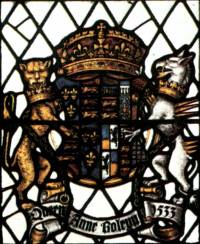 | Song attributed to have been written by Anne (or possibly her brother George) O Death, O Death, rock me asleepe, Bring me to quiet rest; Let pass my weary guiltless ghost Out of my careful breast. Toll on, thou passing bell; Ring out my doleful knell; Thy sound my death abroad will tell, For I must die, There is no remedy. My pains, my pains, who can express? Alas, they are so strong! My dolours will not suffer strength My life for to prolong. Toll on, thou passing bell; Ring out my doleful knell; Thy sound my death abroad will tell, For I must die, There is no remedy. Alone, alone in prison strong I wail my destiny: Woe worth this cruel hap that I Must taste this misery! Toll on, thou passing bell; Ring out my doleful knell; Thy sound my death abroad will tell, For I must die, There is no remedy. Farewell, farewell, my pleasures past! Welcome, my present pain! I feel my torment so increase That life cannot remain. Cease now, thou passing bell, Ring out my doleful knoll, For thou my death dost tell: Lord, pity thou my soul! Death doth draw nigh, Sound dolefully: For now I die, I die, I die. <a class="external" href="http://www.leonarda.com/mp3s/Leonarda-340-Boleyn.mp3" rel="nofollow" target="_blank" title='Hear a clip from "Oh Death Rock Me Asleep"'>Hear a clip from the song "Oh Death Rock Me Asleep"</a>
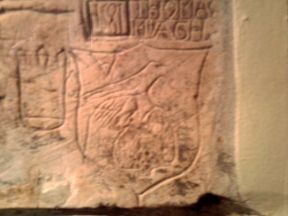 An unknown prisoner carved a likeness of Anne's Falcon badge, fittingly without the crown and sceptre, but mounted atop the rose bush emblem of the Tudors, in the wall of the Beauchamp Tower in the Tower of London. This tower provided an excellent view of Tower Green, where Anne was executed. | ||
| Anne Boleyn's remains are buried beneath this seal on the altar floor. Her brother George Boleyn is buried close by within the same chapel, along with Jane Boleyn (George's wife who testified against Anne & George), and their cousin Katherine Howard. 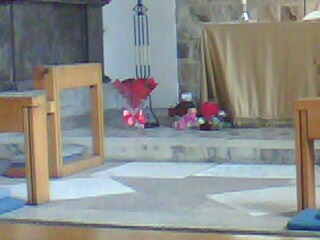 | The Catling memorial on Tower Green. "Gentle visitor pause a while, Where you stand death cut away the light of many days, Here, jewelled names were broken from the vivid thread of life, May they rest in peace while we walk the generations around their strife and courage, |
|
Myths and legends of Anne BoleynMany myths and legends about Anne Boleyn have survived over the centuries. One is that she was secretly buried in Salle Church in Norfolk under a black slab near the tombs of her Boleyn ancestors. Her body was said to have rested in an Essex church on its journey to Norfolk. Another is that her heart, at her request, was buried in Erwarton by her uncle Sir Philip Parker. Arwarton or Erwarton is a village and civil parish in the Babergh district of Suffolk, England. Located on the Shotley peninsula around south of Ipswich,Suffolk <a class="external" href="http://www.reephambenefice.org.uk/anneboleynsburial.html" rel="nofollow" target="_blank" title="Where was Anne buried?">Where was Anne buried?</a> |
For MORE on the history of Anne Boleyn click: |
